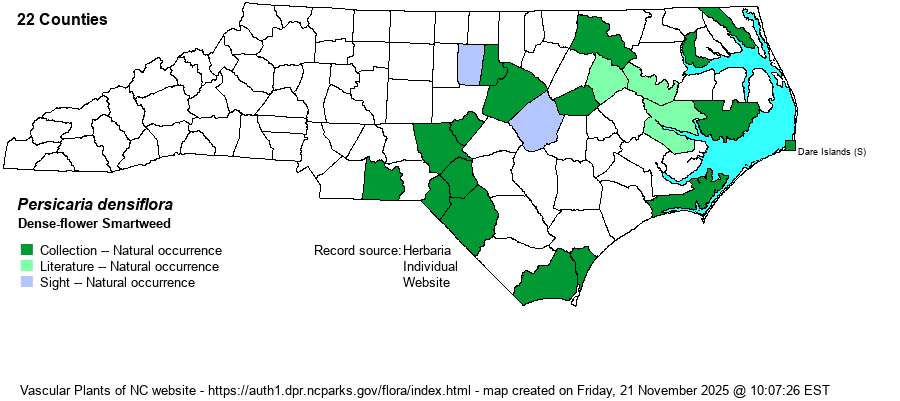| Section 6 » Family Polygonaceae |
Show/Hide Synonym
| taxonName | relationship | relatedTaxonName | relatedTaxonRefText | relComments |
|---|
| Persicaria densiflora | < | Persicaria glabra | Flora of North America (1993b, 1997, 2000, 2002a, 2002b, 2003a, 2004b, 2005, 2006a, 2006b, 2006c, 2007a, 2009, 2010) | | | Persicaria densiflora | < | Persicaria glabra | | | | Persicaria densiflora | < | Persicaria glabra | | | | Persicaria densiflora | < | Persicaria glabra | | | | Persicaria densiflora | < | Persicaria glabra | | | | Persicaria densiflora | < | Persicaria glabra | Flora of Virginia | | | Persicaria densiflora | = | Polygonum densiflorum | Gleason and Cronquist (1991) | | | Persicaria densiflora | = | Polygonum densiflorum | Fernald (1950) | | | Persicaria densiflora | = | Polygonum densiflorum | Gleason (1952) | | | Persicaria densiflora | = | Polygonum densiflorum | Godfrey and Wooten (1979, 1981) | | | Persicaria densiflora | = | Polygonum densiflorum | | | | Persicaria densiflora | = | Polygonum densiflorum | Radford, Ahles, and Bell (1968) | | | Persicaria densiflora | = | Polygonum densiflorum | Wunderlin & Hansen Flora of Florida (3) | | | Persicaria densiflora | = | Polygonum densiflorum | | | | Persicaria densiflora | = | Persicaria portoricensis | Small (1933, 1938) | , illegitimate name | | Source: Weakley's Flora |
|
| Author | (Meisner) Moldenke | |
| Distribution | Widely scattered over the Coastal Plain and adjacent lower Piedmont (where rare).
Southern NJ to KY and MO, south to FL and TX; Mex., C.A., S.A. | |
| Abundance | Rare to locally uncommon in the Coastal Plain, and very rare in the lower Piedmont. However, may be common where found, as it occurs in dense stands (like most others in the genus). A huge population found in 2020 at Leith Creek, Scotland Co., was dominant beneath cypress-gum. This is a Watch List species. | |
| Habitat | Freshwater marshes, fresh-tidal marshes, swamp forest openings, backwater channels of floodplain forests, interdune marshes, wet roadside ditches. |
| Phenology | Flowering and fruiting June-October. | |
| Identification | Dense-flower Smartweed is typically robust, with stems 3-6 feet tall and up to 3/4-inch thick near the base, hairless, and red-colored. The ocreae are greenish to tan. The lower leaves are elliptical, whereas the middle and upper stem leaves are lance-shaped with rather long apices. Inflorescences (spikes) may reach 4 inches, erect to only slightly curved/drooping, and are densely flowered; the sepals are rosy and glandular-dotted, the petals white. Pale Smartweed (P. lapathifolia) may be as tall, but it lacks the thick perennial rhizome, seeds are concave on at least one surface, and the long but narrow inflorescence typically arches or droops. Its spikes are more slender and pale pink to mostly white, as opposed to a pink color of a thicker spike in Dense-flowered Smartweed, and its sepals lack glands. | |
| Taxonomic Comments | Some authors lump it into the pantropical P. glabra. Many references still name it as Polygonum densiflorum.
Many species formerly treated in the genus Polygonum have been moved to Persicaria, the smartweeds. These are generally erect and tall plants with terminal and axillary floral spikes; most occur in wetlands. Others remain in Polygonum, the knotweeds, which are generally prostrate to ascending and with inconspicuous axillary flowers. They occur mostly in dry soils and tend to be weedy.
Attention must be paid to the small collars at the junction of the main stem and leaf stems (called ocreae) and whether they possess terminal hairs or bristles. Some keys also refer to the even smaller collars from which flowers emerge (called ocreolae). Another important ID character is the surface of the greenish sepals -- whether smooth or dotted with indentations (punctate). | |
| Other Common Name(s) | Dense-flower Knotweed | |
| State Rank | S3 [S2S3] | |
| Global Rank | G5 | |
| State Status | W1 | |
| US Status | | |
| USACE-agcp | | |
| USACE-emp | | |

